![]()
![]()
![]()
Use LEFT and RIGHT arrow keys to navigate between flashcards;
Use UP and DOWN arrow keys to flip the card;
H to show hint;
A reads text to speech;
197 Cards in this Set
- Front
- Back
- 3rd side (hint)
|
Ammrl |
CNAP CNAL 13650.3 |
|
|
|
What do you do if SE does not match info on ATR |
Info on ATR must be used, then submit a Re-identification (RE) TR after, as required |
|
|
|
Types of SE TR per AMMRL (4) |
GI - Gain by inventory RE - Reidentification SC -Status Change SI - Survey |
|
|
|
STATUS CHANGE F6 |
If item is lost, missing, stolen conduct search Must not exceed 90 days in this status If not found process dd200 and SI TR |
|
|
|
Criteria for SI TR |
Missing lost or stolen SE SC TR to reflect F6 status Dd200 Or GPETE SE determined beyond economical repair by appropriate level maintenance |
|
|
|
Barcode |
All se must have a barcode |
|
|
|
NA 00-25-100 |
NAVAL AIR SYSTEMS COMMAND TECHNICAL PUBLICATIONS LIBRARY MANAGEMENT PROGRAM |
|
|
|
ACC |
Aircraft controlling custodian |
|
|
|
AIDR |
Acceotance inspection deficiency report |
|
|
|
Aimd |
AIRCRAFT INTERMEDIATE MAINTENANCE DEPARTMENT |
|
|
|
AIRS |
Airworthiness issue resolution system |
|
|
|
AWSE |
Aircraft weapons support equipment |
|
|
|
CASS |
Consolidated Automated Support System |
|
|
|
CTPL |
Central Technical Publications Librarian |
|
|
|
Dtpl |
Dispersed technucal publications librarian |
|
|
|
ELAR |
Electronic local assust request |
|
|
|
Elms |
Enhanced library management system |
|
|
|
Erac |
electronic rapid action change |
|
|
|
Etims |
Enhanced technical information management system |
|
|
|
Ietm |
Interactive electronic technical manual |
|
|
|
Imrl |
Individual material readiness list |
|
|
|
Jdrs |
Joint deficiency reporting system |
|
|
|
Jedmics |
Joint engineering data management information control system |
|
|
|
Namdrp |
Naval aviation maintenence discrepancy reporting program |
|
|
|
Pema |
Portable electronic maintenance aid |
|
|
|
Pmic |
Periodic maintenance information card |
|
|
|
Pmrm |
Periodic maintenance requirements manuals |
|
|
|
Sepms |
Support equipment planned maintenance system |
|
|
|
Pqdr |
Product wuality deficiency report |
|
|
|
Rac |
Rapid action change |
|
|
|
Ramec |
Rapid action minor engineering change |
|
|
|
Sm&r |
Source maintenance recoverability |
|
|
|
Ssic |
Standard subject identification code |
|
|
|
Tdmis |
Technucal data management infirmation system |
|
|
|
Tdms |
Technical data management specialist |
|
|
|
Tdrs |
Technical directive reporting system |
|
|
|
Tmaps |
Technical manual application system |
|
|
|
Tpdr |
Technical publications drficiency report |
|
|
|
00-80t-96 |
Se basic handling and safety manual |
|
|
|
When would you need a safety observer when driving se around aircraft |
When driving within 5 ft of aircraft diamond |
|
|
|
Only safe means of moving aircraft |
With tow tractor and no engines running |
|
|
|
Towing capacity vs drawbar pull |
Tow tractor can pull 10 times drawbar pull Ex: 8000 drawbar pull =80000 tow capacity |
|
|
|
A/S32A-37 TRACTOR |
Diesel 4wd shore aircraft Class 1: 20,000 drawbar pull Class 2: 35,000 drawbar pull |
|
|
|
Ta-35 |
6cyl diesel, 6 speed auto trans, 4wd 24vdc |
|
|
|
A/S32A-31A |
Dual RWD, Ship tow tractor 8500 drawbar pull 3 cyl, 2 cycle diesel eng 3 speed transmission Hydraulic wet disc brakes |
|
|
|
A/S32a-30a |
Tow se and light aircraft 5000 drawbar pull 4cyl diesel rwd Hydraulic brakes on 4 wheels and removable cab |
|
|
|
A/S32a-32 |
Sd-2 or spotting dolly Ship 14,000 drawbar pull Lifting capacity 16000lbs Max loaded speed 2mph Max unloaded speed 3mph 3cyl diesel, 2 hyd pumps joystick control Each wheel rotates independently at different speeds at opposite directions from eachother |
|
|
|
Material failure make up to how many percent of mishaps |
4 percent |
|
|
|
Operator failure make up to how many percent of mishaps |
96 percent 00-80t-96 ch 5 |
|
|
|
Hazards for tractor to plow ahead vs turning |
Slick, wet, or painted surfaces |
|
|
|
Coupling and disconnecting tractor hazards |
Be mindful of fingers and thumbs when performing tasks |
|
|
|
Td-1a/b hazards |
Do not release under tension. Aircraft damage by chain whip |
|
|
|
When do u remove tiedowns or chocks |
After tractor is attached to aircraft, tractor manned and brake rider in cockpit |
|
|
|
NA 06-30-501 |
Oxygen/nitrogen systems technical manual |
|
|
|
Oxygen boiling point |
90.18 degrees kelvin -182.97 degrees celcius -297.35 degrees fahrenheit 162.32 dergrees rankin |
|
|
|
Nitrogen boils |
77.36 degrees kelvin -195.79 degrees celcius -320.42 degrees Fahrenheit 139.25 degrees rakin |
|
|
|
Conduction |
Heat on one end transfers to the other due to free motion of elections |
|
|
|
Good conductor |
Gold, silver, copper |
|
|
|
Bad conductor |
Glass asbestos Low co ductors make great insulation |
|
|
|
Convection |
When energy is transferred between solid surface, moving gas, or liquid Motion of liquid can be natural or forced Example: gas or liquid is heated The hotter lighter fluid rises while colder heavier fluid sinks. This is natural convection or non uniformity. Forced convection occura when you subject the fluid to pressure |
|
|
|
Oxygen |
Colorless, odorless, tasteless, slightly magnetic gaseous element. Can be condensed to pale blue liquid Boils at -297.33° F or 182.96°C |
|
|
|
Expansion ratio of liquid oxygen |
861:1 |
|
|
|
Nitrogen |
Colorless, odorless, tasteless nontoxic inert gas Can be condensed to colorless liquid Can be compressed to colorless crystalline solid |
|
|
|
Liquid nitrogen boiling point |
-320.42°F -195.79°C
Expansion ratio: 696:1 Fun fact: liquid nitrogen has lower boiling point than liquid oxygen. Therefore distills off first and can be collected. |
|
|
|
Cryo hazards |
Cold burns
Ppe: goggles face shield gloves boots apron and cleanliness Work in groups of 2 or more Ventilated spaces |
|
|
|
Fire or explosion requirements |
Oxidant, fuel, and ignition source Example: oxygen, non compatable material or flammable gas, mechanical or electrical spark |
|
|
|
Whe working or handling liquid oxygen signs should be posted |
Within 50 feet to restrict smoking, sparking or open flames
|
|
|
|
Grounding of cryo gear |
All gear should be grounded Certified ground point has resistance of 10000 ohms or less Tested 14 month intervals |
|
|
|
Slings |
17-1-114. Series 17-600-183-6-2 |
|
|
|
00-80t-119 |
Na weight handling support equipment manual |
|
|
|
Proofload test |
200% of swl (Swl×2) |
|
|
|
Slings shall not be used at horizontal angles less than |
30 degrees |
|
|
|
SWL for non verticle angles of loading |
(Single leg verticle swl) x (#of legs) x (sine of minimum horizontal angle) |
|
|
|
Reeving wire ropes |
Are not allowed |
|
|
|
3 types of sling hitches |
Verticle, choker and basket hitch |
|
|
|
What type of slings are authorized for use on naval aircraft and components |
Only imrl aircraft support equipment slings |
|
|
|
Fabric webbing sling storage in |
Cool, dry, and dark place to avoid ultraviolet light damage |
|
|
|
What to do if newly manufactured slings are aquired through supply system or depot without proofload tag |
Initiate QDR quality deficiency report to sling cognizant activity, FST or NAVICP, or depot rework activity
IAW NAMP AND 17-1-224.1 WP 4 PG 3 |
|
|
|
Do not check for broken wires by |
Running bare hands over wire rope |
|
|
|
3 ways to check for bad wire |
-6 broken wires in one one rooe lay randomly distributed -3 broken wires in one strand per rope lay randomly distributed -one broken wire within one rope lay length of any end fitting |
|
|
|
Sling tags |
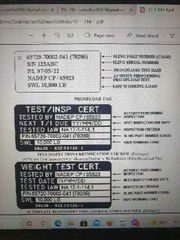
|
|
|
|
Fabric sling marking |
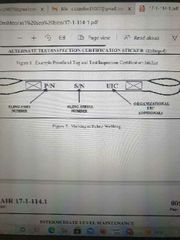
|
|
|
|
If sling does not have proofload tag, but has certificate |
Proofload tag can be generated |
|
|
|
If sling does not pass preop |
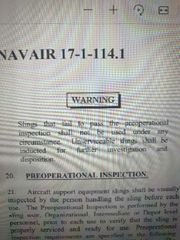
|
|
|
|
When doing flourescent penetrant inspection for ndi |
Do not particle blast aluminum, brass or soft metals Particle blasting steel is allowed |
|
|
|
Hook inspection criteria |
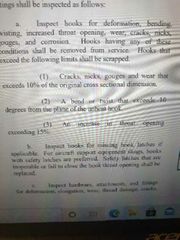
|
|
|
|
Blending criteria |
Cracks, nicks, gouges, and pits are repairable as 90 percent of the area is intact Area will be ndi inspected If area is 10 percent or more. Component will be replaced |
|
|
|
Weld |
Weld repair shall be proofload tested and ndi and visually inspected |
|
|
|
Proofload test for not less than |
3 minutes Do not stand on or near sling in tension or under load Do not apply proofload suddenly especially in cold weather to prevent overloading or shock loading |
|
|
|
Chain link wear |
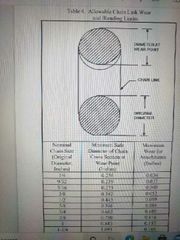
|
|
|
|
Abrasives |
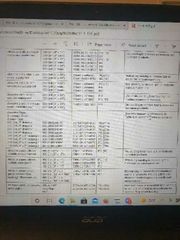
|
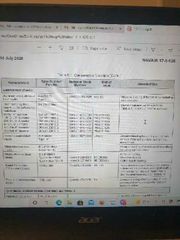
|
|
|
Warning |
Injury or death |
|
|
|
Caution |
Destruction or damage to equipment or loss of mission effectiveness |
|
|
|
Note |
Essential procedure that must be highlighted |
|
|
|
Four conditions for corrosion to occur |
Metal or the anode Dissimilar conductive material (cathode) Conductive liquid (electrolyte) Electrical contact (usually metal to metal contact) |
|
|
|
12 types of corrosion |
Uniform surface Galvanic Intergranular Exfoliation Crevice Pitting Stress Hydrogen embrittlement Fatigue Filiform Fretting Erosion |
|
|
|
Corrosion of metals |
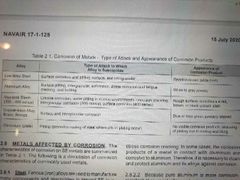
|
|
|
|
Cleaning battery spills |
Litmus powder for lead acid batteries (Solution is 70% alcohol, 30% distilled water, one tablespoon of litmus in a pint spray bottle). Then use 10% sodium bicarbonate (mix is one pint of fresh water and two ounces of sodium bicarbonate) Bromothymol blue solution for nicad batteries. Then 3% boric acid solution (mix is one pint of solution then use a dropper to add boric acid until solution goes from blue to gold/amber) These solutions identify contaminated areas and when they are neutalized |
|
|
|
Deflated tire pin length |
Needs to be a minimum of 3/4 long and enxtend a minimum of ¹/4 past cap |
|
|
|
If tires and wheels need to be removed to FOM tires should |
Be deflated 50% or 15psig whichever is lessor prior to loosening lugnuts and removing T&W assy |
|
|
|
Bolt size to torque value |
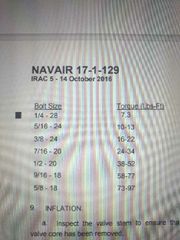
|
|
|
|
When inflating tires |
Ensure placed in tire inflation booth or equivalent restraining device rated for size and inflation. May explode violently due to defects or improper assembly |
|
|
|
When servicinf do not use remote controller with |
Higher relief valve setting than required |
|
|
|
When inflating wheel in inflatiin cage personell shall not |
Rest or lean on inflation cage |
|
|
|
For high pressure SE aircraft tires use |
Nitrogen servicing unit |
|
|
|
No attemots shall be made to correct seating of tire beads or rim flange while |
Tire is pressurized |
|
|
|
If tire deflated tag pin does not meet required length that may enable |
Tag to be screwed on with valve core still installed |
|
|
|
When seating bead never exceed tire service pressure because |
Beads may strike the flange with enough force to break, jump the flange and damage tire |
|
|
|
Before inflating ensure |
All personell are clear of rim/tire trajectory area |
|
|
|
Always inflate demountable flange tire and wheel assemblies in |
A tire inflation cage to prevent serious injury or loss of life Never over inflate Never attempt to seat lockring during/after inflation |
|
|
|
When inflating never place hands |
Near bead seat or rim flange |
|
|
|
Deflate tire, remove valve core, install tire deflated tag If valve extention is installed: remove valve core and extension If any of the following are true: |
Tire is aircraft tire Tire will be demounted from wheel Tire has been driven under inflated for 80 percent or less of servuce pressure There is obvious or suspected damage to tire and wheel conponents |
|
|
|
Threads shall not be oiled |
Torque values are for oil free threads |
|
|
|
When installing bolts/nuts to tire and wheel assembly |
Install in criss cross pattern and refer to tm/mrc for torque value QA |
|
|
|
With tire inflated |
Remove remote controller and let stand for 10 minutes then recheck fir pressure loss |
|
|
|
When a defective bearing is replaced |
The cup of the defective bearing will be replaced at the same time |
|
|
|
A/E32C-45A |
Environmental Control Unit |
|
|
|
Environmental Control Unit |
A/E32C-45A |
|
|
|
Banned refrigerent |
R22 |
|
|
|
Ecu provides |
Heating and cooling to military facilities 208vac, 3 phase, 50/60hz, 3 phase power |
|
|
|
Ecu uses what refrigerent |
R-134a |
|
|
|
Ecu power requirements |
208 vac, 3 ohase, 50/60hz, 6.6 amps |
|
|
|
Ecu cooling capacity |
36,000 btu |
|
|
|
Ecu heat capacity |
76000 btu |
|
|
|
Ecu indoor blower |
1 phase 1625 rpm |
|
|
|
Ecu temp control of department |
40°F-95°F |
|
|
|
Ecu 3 sections |
Indoor airflow Comoressor/ control box Outdoor airflow |
|
|
|
Ecu breakdown |
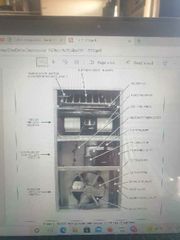
|
|
|
|
Ecu 3 cycles of operation |
Cooling, heating, defrosting |
|
|
|
Ecu can provide air or heat by setting reversing valve |

|
|
|
|
Ecu must be kept uoright to avoid damage to |
Compressor and refrigeration systems |
|
|
|
Dropping or inverting ecu |
May result in loss of refrigerent charge due to seoeratiin of system piping or connections |
|
|
|
Must observe extreme care when working on |
Electrical portions if ecu. May result death or serious injury |
|
|
|
Ecu has two power circuits |
Heat and cool cb should be switched to off and discinnect plugs and cables iaw mim to prevent injury or death |
|
|
|
Prior to fault isolation in ecu |
Discharge capacitor |
|
|
|
Prior to troubleshooting ecu thermostat |
Remove from wall mounting to expose test points |
|
|
|
A/M27T-15 |
Diesel hydraulic power supply |
|
|
|
Diesel hydraulic power supply |
A/M27T-15 |
|
|
|
Prestart procedures of A/M27T-15 must be completed prior to |
Open or closed loop operations |
|
|
|
A/M27T-15 aircraft reservoir closed loop operation |
Is preferred method to be used on aircraft to circulate hydraulic fluid supplied by aircraft without draining aircraft reservoir into t-15. Fluid still circulated through 3 micron filter to purge contaminates |
|
|
|
In order to run A/M27T-15 in aircraft reservoir mode |
Hydraulic system must be intact, full of hydraulic fluid and free of air to prevent A/M27T-15 pumps from cavitating |
|
|
|
Do nit engage starter on A/M27T-15 for more than |
20 seconds If it does not start after 20 seconds allow to rest for one minute |
|
|
|
A/M27T-15 employs a time delay feature to |
Override auto shutdown This allows system tkbuild boist pressure and meet minimum operating parameters during startup |
|
|
|
Excessive use of vent valve on A/M27T-15 may result in |
Aircraft fluid to dump to system reservoir leading to A/M27T-15 pumps to cavitate |
|
|
|
In order to run A/M27T-15 in test stand reservoir open loop operation |
Aircraft requiring nitrogen charge must be fully charged to prevent over filling of aircraft hydraulic systems |
|
|
|
Do not leave A/M27T-15 reservoir selector valve in aircraft reservoir mode for an extended period as this may cause |
A/M27T-15 to cavitate |
|
|
|
When A/M27T-15 reservoir selector valve is switched to test stand |
The aircraft reservoirs will be dumped to A/M27T-15 reservoirs. Esure there is enough spave in A/M27T-15 reservoirs prior Fluid will be returned after by utilizing aircraft fill system |
|
|
|
System oressure on A/M27T-15 must be below 1000 psi prior to |
switching on 5000 psi hp switch |
|
|
|
What must be set prior to setting return back lressure regulator on A/M32A-T15 |
Gear must be running with pressure and flow already set |
|
|
|
Fans will operate on A/M32A-T15 |
30 seconds after unit is turned off |
|
|
|
Emergency stop procedures on A/M32A-T15 |
Apply to both ooen and closed looped operations |
|
|
|
Msu 200nav |

A/U47A-5 |
|
|
|
Msu200 provides |
Aircraft main engine start and comoressed air for ecs systems |
|
|
|
Msu 200 can be mounted on |
Trailer - A/M32U-16A Lframe - A/S32A-49 |
|
|
|
Msu 200 two compartments |
Comoressor and turbine |
|
|
|
FADEC (full authority engine control) OF MSU200 |
Control startup and operation of msu and displays failures thriugh BITE messages |
|
|
|
BITE (built in test equipment) failures |
Self test failures Start up failures Normal operation failures |
|
|
|
Msu200 shore/sea configurations |
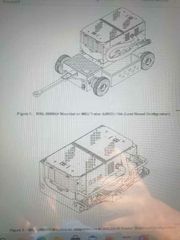
|
|
|
|
Msu200 powerhead |
Hamilton sundstrand |
|
|
|
Msu sections |
Forward compressor cold section Aft turbine hot section |
|
|
|
Msu times |
5sec self test 120 sec warm up period prior to loading |
|
|
|
When ambient temp is below 20°F |
Use external power of 24 to 28 vdc |
|
|
|
Do not pull e stop |
Spring loaded. Push and twist to reset |
|
|
|
Ensure to push off button on msu |
Or else power will continue to drain from batteries |
|
|
|
Msu will not start if starting temp is greater than |
200°F |
|
|
|
Msu will auto shutdown if feeder tank is less than |
30% full |
|
|
|
Start button must be pressed within |
120 seconds of depressing on button or else will fault for no start signal bite message |
|
|
|
To prevent whiplash ensure msu duct |
Has no kinks and is properly locked into place on the coupling mount |
|
|
|
Pneumatic duct is hot after bleed air operations |
Bleed air exceeds 400°F |
|
|
|
After shutdown of msu turbine shaft |
Must come to a complete stop before attempting restart |
|
|
|
Bleed air is directly affected by |
Ambient temperature and barometric pressure Barometric pressure decreases as altitude increases |
|
|
|
O level mmp distributed NLT |
25th of the month prior |
|
|
|
PC work centers |
(Work Center 020, often referred to as “Main” Production Control) and Division Production Controls (Work Centers 024, 025, 026, 027, 028, and 029) |
|
|
|
Sm&R errors |
SM&R Code errors will be immediately reported to the TYCOM Class Desk responsible for the T/M/S aircraft/engine/equipment. SM&R code errors for Aircraft Armament Systems (AAS) will be reported to the TYCOM AAS Class Desk |
|
|
|
Bcm 1 |
Repair not authorized |
|
|
|
Bcm 2 |
Lack of equipment, tools or facilities |
|
|
|
Bcm 3 |
Lack of technical skills |
|
|
|
Bcm 4 |
Lack of parts |
|
|
|
Bcm 5 |
Fails check and test |
|
|
|
Bcm 6 |
Lack of technical data |
|
|
|
Bcm 7 |
Beyond authorized repair depth |
|
|
|
Bcm 8 |
Administrative |
|
|
|
Bcm 9 |
Condemned |
|
|
|
Which bcm can't be delegated |
Bcm 4 lack of parts |
|
|
|
TRR |
Time to reliably replenish |
|
|
|
C1 |
C1: No impact on repair capability. • Repair capability can be maintained with multiple or legacy test benches.
|
|
|
|
C2 |
C2: Impact on repair capability. • Repair turnaround time is able to meet customer demand rate. • AWM backlog is low or none. • Workaround may exist, but is unreliable. |
|
|
|
C3 |
C3: Significant impact on capability. • Repair turnaround time does not meet customer demand rate. • Workaround exists, but cannot meet demand. • Supply reserves may exist, but are or approaching Pool Zero with on-board/on-station replacement assets available but at critical level. • No supply reserves, but no maintenance backlog with no on-aboard/on-station replacement assets available and no immediate requirements exists. |
|
|
|
C4 |
C4: No capability to provide repair/calibration/service. • 1 of 1 bench/test set/OTPS/rolling stock non RFU with no workaround. • 1 of 2 bench/test set/OTPS/rolling stock RFU, but EXREPs cannot be cleared in a timely manner |
|
|
|
SE PMs plus or minus how many days |
3 days |
|
|
|
Cripl |
Consolidated remain in place list When it is not feasible to remove part on aircraft before part arrives. Qualifies as RIP item |
|
|
|
TD kits are not |
Considered supply item and are given a KIN (KIT IDENTIFICATION NUMBER) and assigned COG (cognizance code) 6V |
|
|
|
AVDLR |
Aviation depot level repairables |
|
|
|
Ofc-01 |
Flight Operations Funds (OFC-01) will be used for: (1) Aviation fuels consumed in flight operations. (2) Initial and replacement issues of authorized items of flight clothing and flight operational equipment for pilots and flight crews. (3) Consumable office supplies for aviation squadrons. (4) Aerial film, recording tape, and chart paper consumed in flight. (5) Flight deck shoes and safety shoes used by squadron personnel directly involved in the readiness, launch, and recovery of aircraft. |
|
|
|
Depot level local procurement |
Open purchase a. Navy stock fund allotments are granted by NAVSUP WSS for the specific purpose of permitting local procurement for emergency requirements and limited stocks of centrally managed 1R cognizance material to satisfy priority 1 through 8 or NMCS and PMCS requirements. |
|
|
|
Optar |
Operating target Auditable records will be maintained by all activities with an operating budget |
|
|
|
ASD is compromised of two sections |
Aviation support division is compromised of SRS Supply response section RCU requisition control unit |
|

